Research shows that training a muscle twice per week is superior to once per week, but the merits of training it any more frequently are up for debate (1). Thankfully, for the busy lifter, recent studies also show that you have more flexibility here than you might think.
A 2015 study using elite bodybuilders compared an equal-volume, two-way split done four times per week for four weeks to a 3-day split done six days per week (2). Both groups saw similar increases in size and strength.
A more recent study compared equal training volume spread out over two days (Monday and Thursday) or four days (Monday, Tuesday, Thursday, and Friday) (3). After six weeks of training, both groups improved performance and lower-body mass and the two-day per week group improved upper-body size and body composition.
Yet another study compared training three times vs. six times per week with equal training volume and intensity (4). After six weeks of training, both groups had significantly increased their maximum strength and lean muscle mass.
Look at your busy schedule. Is it easier for you to do...
- Longer, less frequent workouts or...
- Shorter, more frequent workouts?
As long as you get in the work you need, you can use the weekly schedule that suits you best.
- Schoenfeld BJ et al. Effects of Resistance Training Frequency on Measures of Muscle Hypertrophy: A Systematic Review and Meta-Analysis. Sports Med. 2016 Nov;46(11):1689-1697. PubMed.
- Ribeiro AS et al. Effect of Two- Versus Three-Way Split Resistance Training Routines on Body Composition and Muscular Strength in Bodybuilders: A Pilot Study. Int J Sport Nutr Exerc Metab. 2015 Dec;25(6):559-65. PubMed.
- Yue FL et al. Comparison of 2 weekly-equalized volume resistance-training routines using different frequencies on body composition and performance in trained males. Appl Physiol Nutr Metab. 2018 May;43(5):475-481. PubMed.
- Colquhoun RJ et al. Training Volume, Not Frequency, Indicative of Maximal Strength Adaptations to Resistance Training. J Strength Cond Res. 2018 May;32(5):1207-1213. PubMed.





